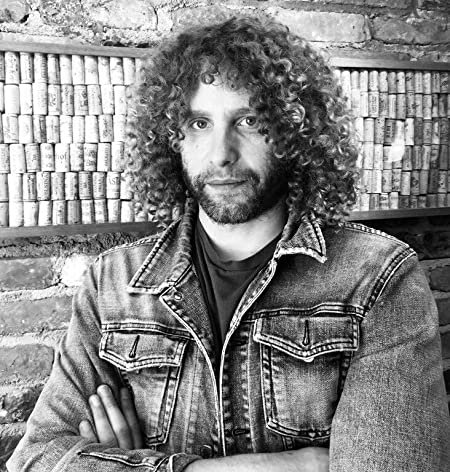“I went to Lars’ house, and he played me the tape of Hit the Lights. I said, ‘This song sucks. You need more guitar solos’”: They forged a new sound, and in 10 years, they were the biggest band in the world
The story of Metallica's meteoric rise – as told by the people who were there, including Dave Mustaine, Scott Ian, Kerry King, Gary Holt, and, of course, Metallica themselves
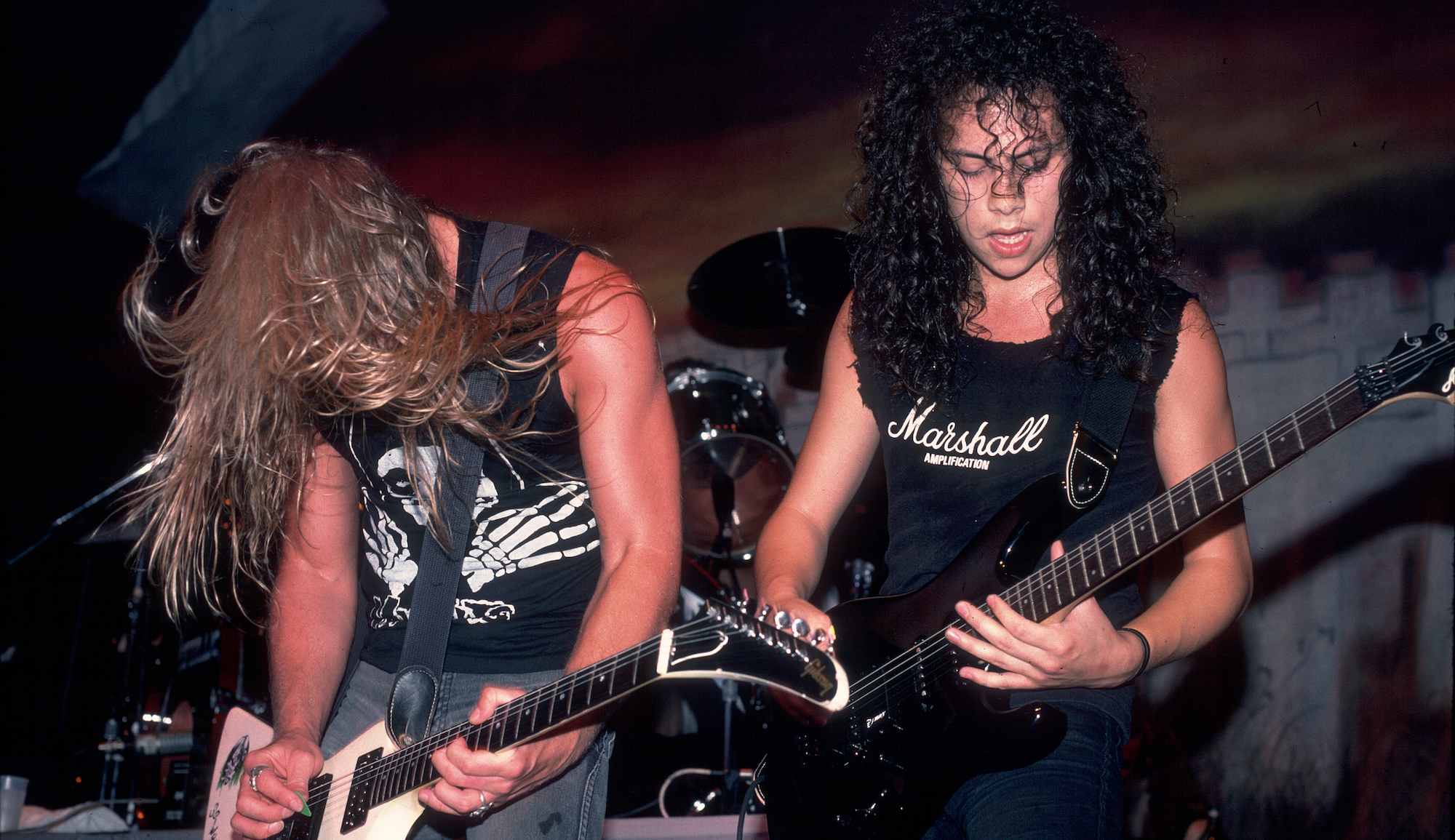
It was in Los Angeles almost 30 years ago that Lars Ulrich, a teenage tennis prodigy turned drummer, first jammed with James Hetfield, a guitarist and singer from the nearby SoCal neighborhood of Downey.
At the time, a none-too-impressed Hetfield figured that first session to be their last. He was, of course, very wrong. As the backbone of Metallica, Hetfield and Ulrich have gone on to perform countless times for millions of fans around the world and to sell many millions of albums.
All of this would not have been possible without the major players who have passed through the band’s ranks over the years, among them guitarist Dave Mustaine, bassist Jason Newsted, and, perhaps most crucial, the late, great bassist Cliff Burton. But no single musician has been beside Hetfield and Ulrich longer than lead guitarist Kirk Hammett, who joined Metallica prior to the recording of their 1983 debut, Kill ’Em All, and whose quick-fingered, melodic soloing is an indispensable element of the band’s sound to this day.
Currently rounded out by bassist Robert Trujillo, Metallica recently released their ninth studio effort, Death Magnetic. The album is being hailed as a return to the band’s thrash metal roots, which makes this an ideal moment to tell the story of those trailblazing early days.
In this exclusive oral history, Hetfield, Hammett, and Ulrich, along with some friends and former band mates, look back on Metallica’s first decade, and recount the recording of their classic first five albums. Through the eyes of those who saw it, heard it, and helped to create the timeless music, Guitar World charts Metallica’s rise from L.A. thrash upstarts to reigning biggest heavy metal band in the world.
In the Beginning
In 1980, 16-year-old Lars Ulrich moves with his family from his native Denmark to Los Angeles. Inspired by Deep Purple and New Wave of British Heavy Metal acts like Diamond Head, Saxon, and Motörhead, Ulrich puts down his tennis racket, picks up a pair of drumsticks, and decides to form a band. Among the first people he meets after moving to L.A. is Brian Slagel, a Southern California teen who would go on to found the independent record label Metal Blade.
Brian Slagel: “Lars would always say, ‘I’m going to start a band one day,’ and I’d be like, ‘Sure man, whatever.’
All the latest guitar news, interviews, lessons, reviews, deals and more, direct to your inbox!
“He had this little drum set in the corner of his bedroom, but it wasn’t even set up. I’d always laugh when I saw it because it was just a big mess. But when I started putting together Metal Massacre [the Metal Blade compilation of local, unsigned metal bands] Lars came to me and said, ‘If I get a band together, can I be on the album?’ Since he was a good friend I said, ‘Absolutely.’”
In the summer of 1980, Ulrich places a classified ad in SoCal paper The Recycler: “Drummer looking for other musicians to jam with – Tygers of Pan Tang, Diamond Head, Iron Maiden.” Guitarist James Hetfield is among the respondents.
James Hetfield: “The first time Lars and I got together to jam, it just didn’t happen. There was no vibe. But he introduced me to a whole new world of heavy music. I had heard of Iron Maiden and Def Leppard, but not too many of the other, more obscure English metal bands.
“I would spend days just going through his record collection, taping over my REO Speedwagon cassettes with bands like Angel Witch and Diamond Head and Motörhead. I was in heaven at his house.”
Slagel: “When Lars heard about the Metal Massacre compilation I was putting together, the two of them recorded Hit the Lights on a little Fostex cassette, and they had their friend, Lloyd Grant, who was a guitar teacher, come in and do the lead.”
Hetfield: “Lars came to me with the opportunity to be on a record, and that was pretty interesting. At that point in my life I wanted to play music. I didn’t want to work.”
Ulrich steals the name Metallica from friend and radio DJ Ron Quintana, who had mentioned it as a possible title for a fanzine he was preparing to launch. Ulrich and Hetfield recruit bassist Ron McGovney, who had played with Hetfield previously in the band Leather Charm, and lead guitarist Dave Mustaine to fill out the band’s lineup.
I remember seeing Dave play with Metallica at the Woodstock in Anaheim. He was ripping these killer solos and riffs, and he was just glaring at the crowd – not even looking at his fingers
Kerry King
Dave Mustaine: “Before the [first] rehearsal, I went to Lars’ house, and he played me the tape of Hit the Lights. I said, ‘This song sucks. You need more guitar solos.’ And Lars went, ‘Oh fuck, reeeeaaallly?’
“I convinced him that I should be in the band and went to rehearsal. I was tuning up when all the other guys went into another room. They weren’t talking to me, so I went in and said, ‘What the fuck? Am I in the band or not?’ And they said, ‘You’ve got the gig.’ It was as easy as that.”
Kerry King: (Slayer guitarist) “I remember seeing Dave play with Metallica at the Woodstock in Anaheim [California]. He was ripping these killer solos and riffs, and he was just glaring at the crowd – not even looking at his fingers. I was blown away.”
In the spring of 1982, the Hetfield-Ulrich-Mustaine-McGovney lineup records a four-song demo with a new version of Hit the Lights. The tape comes to be known as the “Power Metal” demo due to business cards McGovney prints up with the phrase at the time.
Ron McGovney: “Lars said, ‘What did you do! What the hell is ‘power metal’? I can’t believe you did such a stupid thing!’ He was so pissed off at me.”

In late 1982, while trying to replace McGovney, Ulrich and Hetfield spot bassist Cliff Burton onstage with his band, Trauma, at the Whisky a Go Go in L.A. The two ask him to join Metallica. Burton agrees, on the condition that the band relocate to his hometown of San Francisco.
Slagel: “Metallica had a lot of problems in L.A. because all the club owners thought they were either too heavy or too punk. They went over so much better in San Francisco than they ever did in their hometown.”
Gary Holt: (Exodus guitarist) “When they first came to the Bay Area, L.A. was known for nothing more than a lot of shit bands. And then here comes this band, and we’re all into the same stuff – Diamond Head, Budgie… Metallica came along and started playing everywhere.”
Prior to Burton’s joining, Metallica had recorded the No Life ’Til Leather demo, which featured much of the material that would eventually comprise Kill ’Em All. The demo becomes a hot item on the underground tape-trading circuit.
Holt: “The tape-trading scene was how we all got heard. You would record a demo and the traders would circulate it all over the world – to all the fans, the magazines, and the independent record labels.”
King: “Metallica’s demo got passed around, big time. We all had that.”
Scott Ian: (Anthrax guitarist) “When I heard No Life ‘Til Leather I immediately thought, ‘Wow, here’s some guys from the other side of the country that are doing the same thing we’re doing; they’re just a little better at it right now.’
“I remember being there the day Jonny Z [Jon Zazula, owner of New Jersey record store Rock N’ Roll Heaven and founder of indie label Megaforce Records] got it in the mail. He put it on, and I was like, ‘That’s fucking killer! Who are these guys?’ Jonny told me, ‘They’re called Metallica, and I’m bringing them to New York. Somehow we’re gonna make a record.’”
Jonny Z: “We hustled together $1,500 for them to rent a van to come out to the East Coast and play some shows.”
Metallica set up shop at the Music Building in Queens, New York, where Anthrax practice as well. The band live and rehearse at the space and play their first East Coast gigs.
Ian: “Metallica were opening for Vandenberg [the group guitarist Adrian Vandenberg led prior to joining Whitesnake] at L’amour in Brooklyn, and we were all down there in the afternoon, waiting for them to soundcheck. Mustaine was already shitfaced by 3:30, and he was yelling at Adrian Vandenberg, ‘Get the fuck off the stage! You suck!’ And we were all like, ‘What the fuck, dude? Shhhh!’”
I remember the first time I heard Kirk. He had a feel that very few young players have
Lars Ulrich
Slagel: “Everybody liked to drink back then and have a good time, but Dave could go much further over the line than anyone else would, and you could see that sooner or later that was going to be a problem.”
Ian: “I showed up at the Music Building for band practice one day, and Cliff was outside smoking a cigarette. He told me they had just kicked Dave out of the band. The other guys said, ‘We had known we were gonna do it for weeks now. We woke him up this morning, and he was so drunk and hungover that before he could even realize what was going on we got him out of here.’
“I asked them what they were going to do, and they said they already had another guy on his way into town. His name was Kirk Hammett, and he was the guitar player in Exodus.”
Kirk Hammett: “I was familiar with Metallica’s music before I joined the band. I had the No Life ‘Til Leather demo, and my friends and I listened to it quite a bit. It was what everyone in the San Francisco underground metal scene was listening to in 1982. Plus, Exodus played with Metallica pretty often in San Francisco.
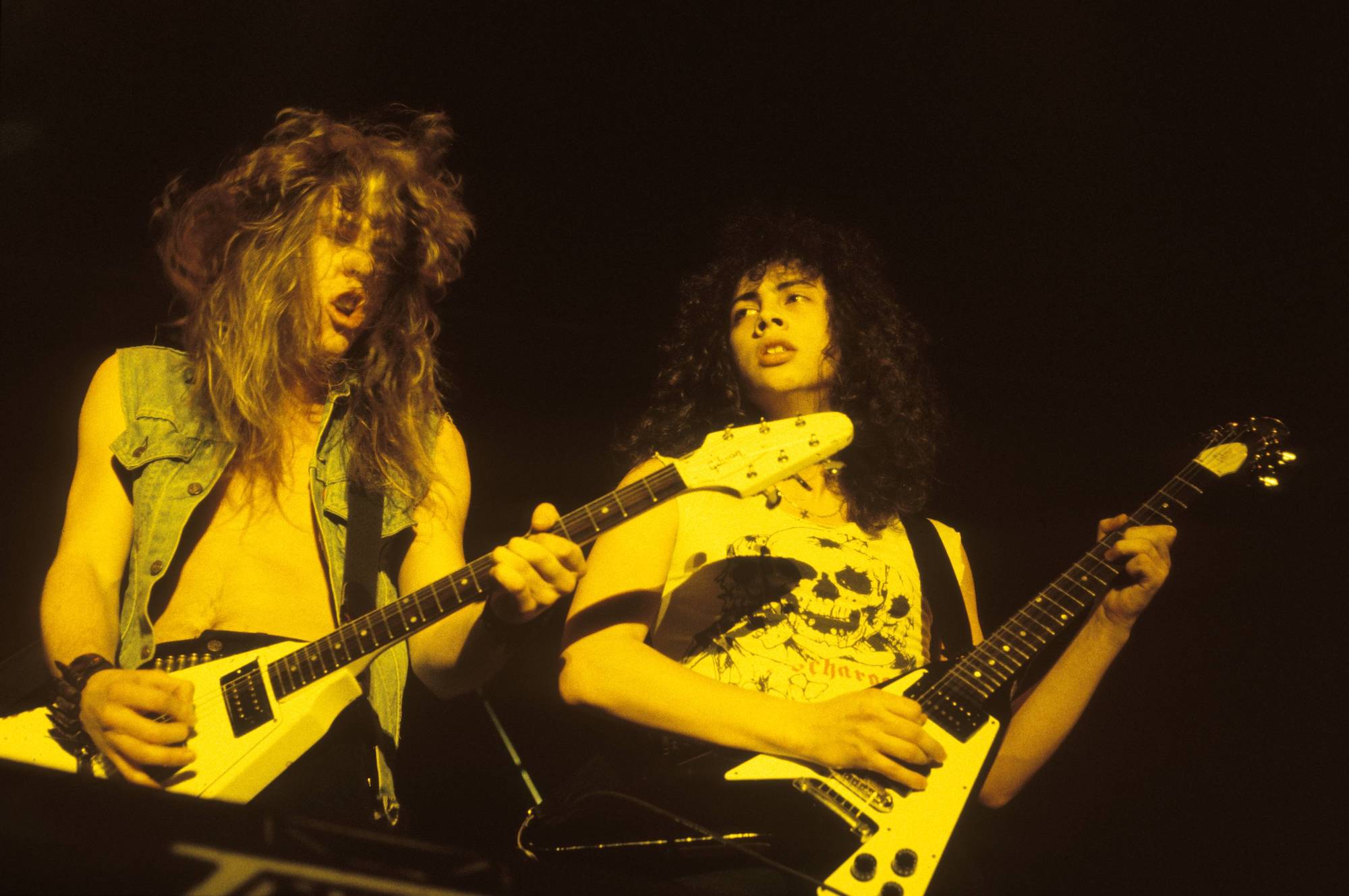
“The first time I spoke to Lars was after they had just finished a set and I said, ‘Thanks for letting us play. I really like you guys.’ He said, ‘Yeah, yeah, cool, cool,’ but as I was talking to him, he started taking his stage clothes off, and before I knew it he was just completely naked in front of me, and I was just shocked. I said to myself, ‘Oh, he’s European. Europeans do stuff like this.’”
Lars Ulrich: “I remember the first time I heard Kirk. He had a feel that very few young players have – very rooted in European metal. It was really nice to hear an American guy who didn’t play like Eddie Van Halen.”
Kill ’Em All
In the spring of 1983, Metallica travel to Music America Studios in Rochester, New York, to record their debut album, Kill ’Em All, with producer Paul Curcio.
Hammett: “We totally trashed the place. I felt bad. But it’s four guys, you know? There was carpet in every single room, and we drank pretty much 24 hours a day back then. So you can imagine how that turned out. Moist places shouldn’t have rugs.”
Ulrich: “The actual studio was in the basement of this huge old colonial-type of clubhouse. On the second floor there was a huge ballroom; perfect for getting a good drum sound. The problem was the place was fucking haunted. My cymbals would start spinning for no reason. Shit like that. It was scary.”
Hetfield: “Occasionally we put guitar and bass amps in the [ballroom] for ambience. I remember Cliff being in that room with all his amps and his headphones on while he recorded (Anesthesia) Pulling Teeth, his bass solo. He literally was just standing in front of his amps.”
Hammett: “The guitar stuff was recorded through James’ magical, mythical Marshall. He had it modified by some guy in L.A. who used to work on Eddie Van Halen’s gear. I used it too, because we didn’t have much equipment back then. I also used a wah pedal and a Boss Super Distortion. James played his white Flying V, and I used my black Flying V. Those were the only guitars we had.”
Hammett, who has only been in the band a few months, still has to contend with the looming presence of Dave Mustaine, who had written many of the riffs and solos to the songs.
Hammett: “Jonny Z said, ‘You know, you have to play Dave’s solos.’” I said, “‘No, I don’t really want to play Dave’s solos.’ He said, ‘Why don’t you play the opening to every solo, so that people think you’re going to play Dave’s solos, and then you can go somewhere else with them.’ And that’s exactly what I did.
“As a 20-year-old kid, put in a position like that, you don’t want to rock the boat too much – especially being the new guy. So I took the first four bars of most of the solos and changed them.”
Hetfield: “Dave brought the song The Four Horsemen over from one of his other bands. Back then it was called The Mechanix. After he left Metallica, we kind of fixed the song up. The lyrics he used were pretty silly.”
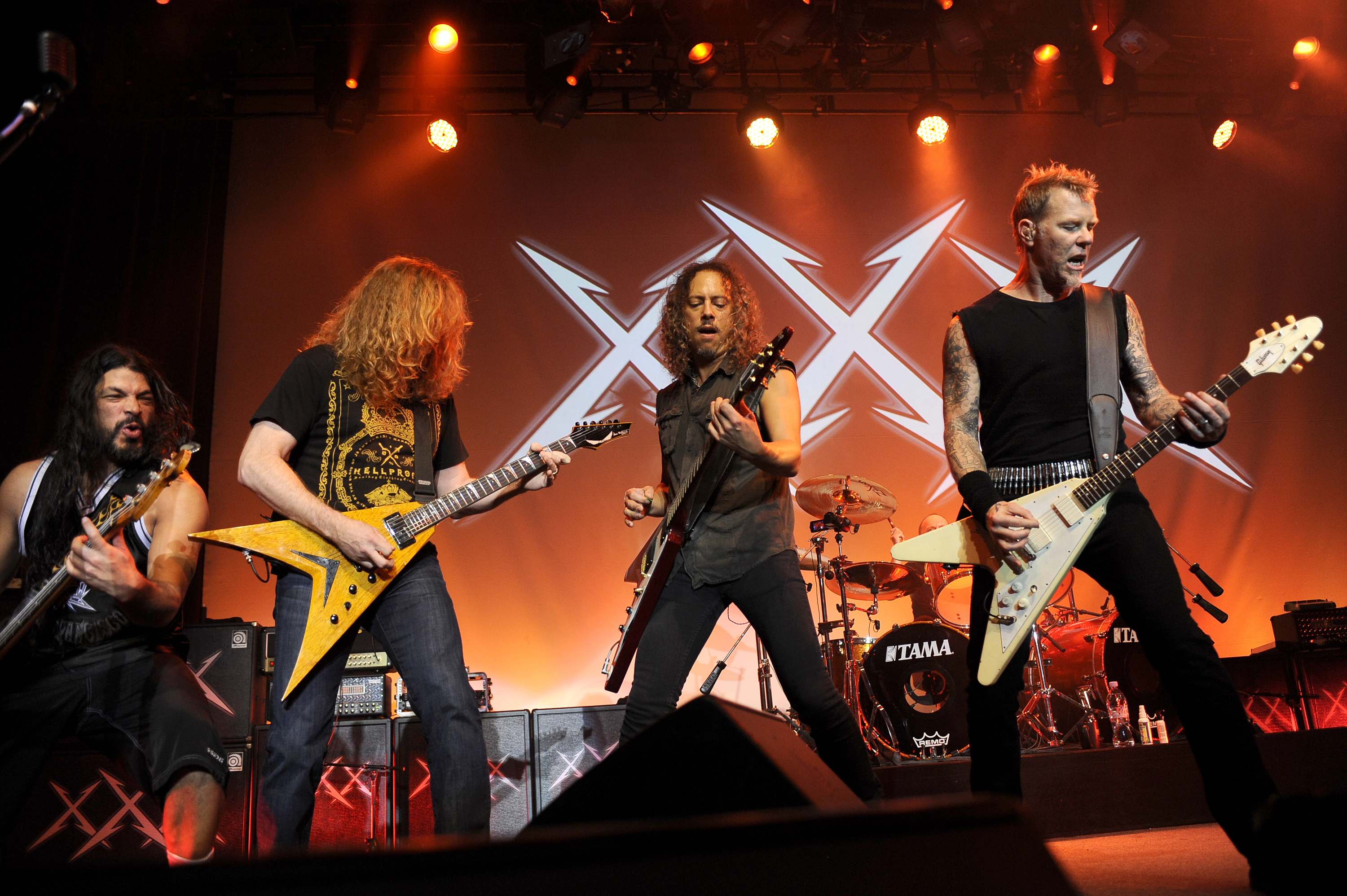
Kill ’Em All is released on July 25, 1983, on Megaforce. Though the first wave of thrash bands, including Exodus, Slayer, Anthrax, and Overkill, are up and running, Metallica are the first act to record and release a full-length vinyl album.
Hetfield: “It was Cliff who named the album. Originally we were supposed to call it ‘Metal Up Your Ass.’ We got a phone call from our manager telling us half the record outlets wouldn’t carry the album if it was called that. Cliff said, ‘You know what? Fuck those fuckers, man. We should just kill ’em all.’”
Hammett: “After we recorded the album and we came back to the Bay Area, there seemed to be 10 or 12 newer bands that were playing faster, really aggressive beats.”
We printed up 1,500 copies, and they went in five seconds. We printed another 3,500, and they went in a week
Jonny Z
David Ellefson: (former Megadeth bassist) “I remember early on Dave [Mustaine] got a fan letter from some kid in the Bay Area who wrote, ‘Can’t wait to hear your new stuff. Hope it’s faster than Metallica.’ We went to rehearsal the next day and everything jumped up 50 beats per minute!”
Hammett: “Part of the reason why we would play so fast is because we were just nervous. As a young musician, when I was nervous I had a tendency to speed things up. Joining Metallica, I thought, ‘This is great, because it can never be too fast.’”
Hetfield: “Lars was always nervous onstage, so he’d play faster and faster. Nobody wanted to wimp out and tell him. We just figured, ‘Hell, we’ll just play fast, too,’ and that’s what we did on the record.”
Hammett: “I would have been happy selling [a few] copies and being able to do a club tour across the States. To me, that was success. Then when we found out we were actually going to go to Europe and play shows there for the first time – I thought, ‘Oh my God, that’s totally unexpected.’
“For James and Cliff and myself, we had never been outside the United States. It was all very inspiring, because there were more possibilities out there than we imagined at the onset.”
Ian: “Jonny Z had been trying to land Metallica a deal, and all the guys at the big labels would put their fingers in their ears when he played them the album. They were clueless. But when they saw how many copies Jonny sold, they realized, ‘Wow, there’s thousands of kids out there who are into this shit.’”
Jonny Z: “We printed up 1,500 copies, and they went in five seconds. We printed another 3,500, and they went in a week. We just kept on building and building, and then Elektra picked them up for Ride the Lightning.”
Ride the Lightning
After completing a European tour opening for Venom in early 1984, Metallica travel to Sweet Silence Studios in Copenhagen, Denmark, to record their second album, with producer Flemming Rasmussen.
The result, Ride the Lightning, is issued on Megaforce on July 27. A few months later, after a gig in New York City, the band is signed by Elektra, making them the first thrash metal act to be picked up by a major label. Elektra then reissues Ride the Lightning in the fall of 1984.
Ulrich: “Cliff was responsible for a lot of the things that happened between Kill ’Em All and Ride the Lightning. He really exposed James and I to a whole new musical horizon of harmonies and melodies. [Our] whole way of writing songs together was very much shaped around Cliff’s musical input.”
Hetfield: “Touring definitely made us a little more worldly. We started to see other things that were going on in the world. And that’s when more of the punk-oriented, opinionated kind of thoughts began to appear in our lyrics. And actually having to sit down and write an album made a difference, because Kill ’Em All was just songs we had been playing in clubs for the two years before we recorded it.”
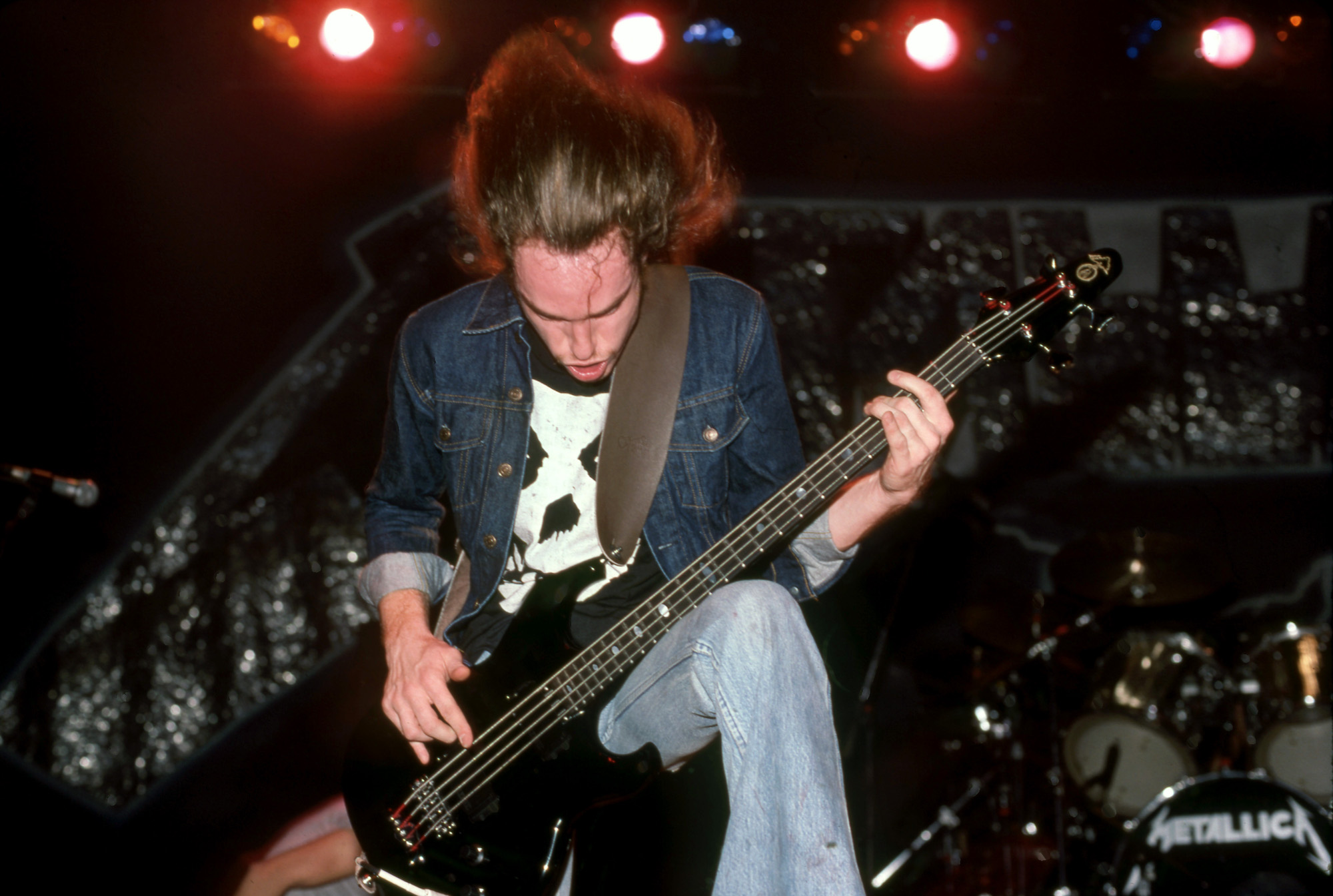
Hammett: “I tracked the whole album with Marshall amps and my Gibson Flying V, and by then James had his Gibson Explorer.”
Hetfield: “That whole album was a real huge step for us. Creeping Death was our first big, chanting, gang-vocal thing. There was almost some production value to it!”
Hammett: “When we did the crunchy ‘Die by my hand’ breakdown in the middle, we sat in the control room after we did the gang vocals, and everyone was just going nuts!”
In addition to thrashy cuts like Creeping Death, Fight Fire with Fire, and For Whom the Bell Tolls, the album features the song Fade to Black, which many consider the first thrash-metal ballad.
Slagel: “Metallica really pushed the boundaries with Fade to Black. That was the first time any of the bands tried something like that. I remember some of their hardcore fans accused them of selling out with that song, but it’s pretty obvious that it’s just a great, extremely well-written tune.”
Hetfield: “It’s a suicide song, and we got a lot of flack for it; kids were killing themselves because of the song. But we also got hundreds and hundreds of letters from kids telling us how they related to the song and that it made them feel better. It was also pretty much our first ballad, so it was challenging, and we knew it would freak people out.”
Hammett: “For the extended solo at the end I wasn’t sure what to play. We had been in Denmark for five or six months, and I was getting really homesick. Since it was a somber song and we were all bummed out anyway, I thought of some depressing things when I did the solo – and it really helped!
“When that was finished, I went back and did the clean guitar parts behind the verse. James played an arpeggiated figure while I arpeggiated three-note chords. We ended up getting a very Dire Straits–type of sound.”
Hetfield: “Bands like Exodus and Slayer don’t do ballads, but they’ve stuck themselves in that position, which is something we’ve never wanted to do. Limiting yourself to please your audience is bullshit.”
Suddenly we were selling albums, and a lot of it had to do with playing our asses off, putting on a great show – just bringing the music to the people in that way, because radio wasn’t having us
Kirk Hammett
With the support of Elektra, Metallica begin to make inroads to the mainstream. Throughout 1984 and 1985 the band tour the world, embarking on the ‘Bang the Head That Doesn’t Bang’ tour across Europe and playing the U.S. with W.A.S.P. and Armored Saint.
In August of 1985, Metallica appear at the Day on the Green festival in Oakland, California, where they perform before an audience of 60,000. That same month, they play to more than 70,000 at the Monsters of Rock festival in Donington, England, where they’re sandwiched on the bill between Ratt and Bon Jovi.
Hetfield: (onstage at Monsters of Rock) “If you came here to see spandex, eye makeup, and the words ‘Oh baby’ in every fuckin' song, this ain't the fuckin' band.”
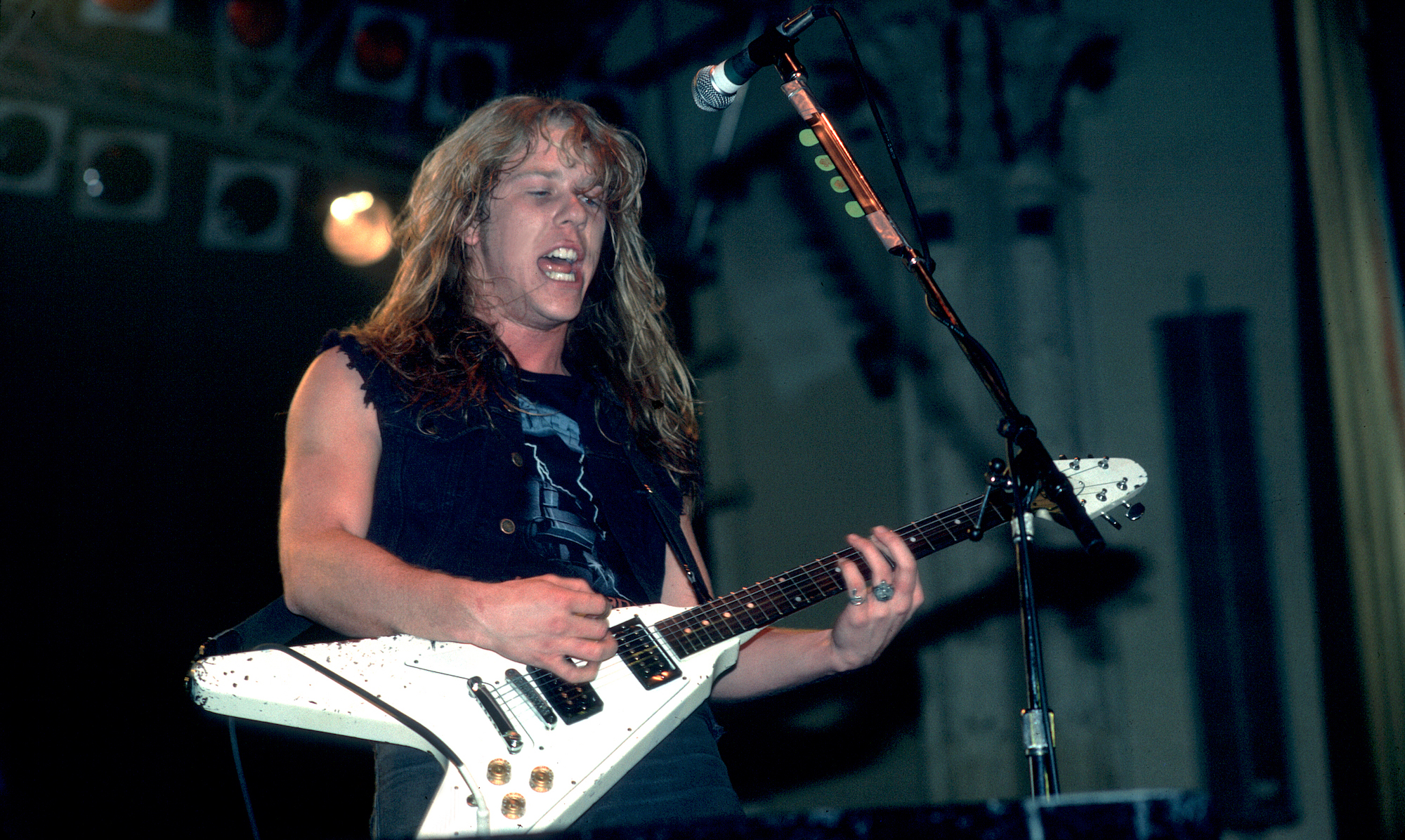
Master of Puppets
After touring for much of the year, Metallica return to Sweet Silence Studios in September 1985, to begin work on their third album, Master of Puppets, again with Flemming Rasmussen at the helm.
Hammett: “By that point, we had been playing together for a few years. We’d toured a ton; we knew each other musically and personally; everybody was contributing amazing ideas, and it was just a culmination of all the right spots and all the right notes at the right time. Maybe the planets were aligned or something, I don’t know, but that’s what it felt like.”
Hetfield: “We started getting into the longer, more orchestrated songs. It was more of a challenge to write a long song that didn’t seem long.”
Hammett: “I’ll tell you how the main [descending] riff to Master of Puppets came about. On the Ride the Lightning tour, James would always play the riff in the dressing room, but on the D string, and I’d play it simultaneously on the G string as a parallel-fourths harmony line. It sounded really dorky and funny.
“Then, one day at rehearsal, James said, ‘Let me show you this really heavy song intro,’ and proceeded to play that exact riff on the low E string. I said, ‘Ah, so you finally found a use for that dorky little thing!’ It’s anything but dorky now.”
Hetfield: “The riff for the title track was pretty messy – constantly moving. But it works good live. People love to scream Master! a couple of times.”
Hammett: “I used a Mesa/Boogie Mark II-C head and my Jackson Randy Rhoads V on that song. When you listen to the solo, there’s this weird sound right after the mellow part where it sounds like I’m hitting a super high note, like I’m fretting the string against the pickup.
“What happened was, I accidentally pulled the string off the fretboard, and it fretted out on the side of the neck! I heard it back and was like, ‘That’s brilliant! We’ve gotta keep that!’ Of course, I’ve never been able to reproduce it since.”
Master of Puppets is released on March 3, 1986. In addition to the epic title track, the album features incredibly aggressive material like Battery, Damage, Inc., and Disposable Heroes, as well as a second ballad, Welcome Home (Sanitarium).
A Sticker that appeared on the cover of early pressings of Master of Puppets read: “The only track you probably won't want to play is Damage, Inc. due to the multiple uses of the infamous ‘F’ word. Otherwise, there aren't any ‘Shits,’ ‘Fucks,’ ‘Pisses,’ ‘Cunts,’ ‘Motherfuckers,’ or ‘Cocksuckers’ anywhere on this record.”
Hetfield: “The idea for Welcome Home (Sanitarium) came from the movie One Flew Over the Cuckoo’s Nest. Fade to Black worked well, and we wanted to have another slow, clean, picking type of song, this time with a chorus. I had trouble singing that chorus – it’s really high. And the riff for the song was lifted from some other band, who shall remain anonymous.”
Master of Puppets peaks at #29 on the Billboard album chart, and within a few months of its release sells more than 500,000 copies. With no help from radio or MTV, Metallica earn their first Gold-certified album. The band receive a large amount of mainstream exposure from their opening slot on Ozzy Osbourne’s tour in support of his Ultimate Sin album.

Hammett: “Going on the Ozzy tour really made a difference, because all of a sudden we were playing Master of Puppets to a pretty mainstream audience. Your typical Ozzy fan might not have gotten Metallica, but two or three years later, they were all saying, ‘Yeah, I saw Metallica with Ozzy, and they blew him away!’
“We converted people night after night. Suddenly we were selling albums, and a lot of it had to do with playing our asses off, putting on a great show, just bringing the music to the people in that way, because radio wasn’t having us.”
In the fall of ’86, Metallica embark on the European leg of the ‘Damage, Inc.’ tour, with Anthrax supporting.
Dan Spitz: (Anthrax guitarist) “The aura each night when they got onstage was incredible. I imagine Led Zeppelin and Black Sabbath had that same vibe. Seeing Metallica back then, you just knew something big was about to happen. Master of Puppets was the changing of the guard.”
On September 27, while en route to a gig in Copenhagen, Metallica’s tour bus skids off the road near Dorarp, Sweden, and flips over several times. Cliff Burton, asleep in his bunk, is thrown through a window. The bus falls on top of him, killing him instantly. He was 24 years old.
Hetfield: “I saw the bus lying right on him. I saw his legs sticking out. I went to pieces. The driver tried to take Cliff’s blanket to give that to someone else. I just screamed, ‘Fuck that!’ I wanted to kill the guy. I didn’t know if he was drunk or if the bus had skidded on ice. All I knew was Cliff was dead.”
Hammett: “A part of Metallica was lost forever when he died.”
Hetfield: “The only thing I could think was: ‘The band? No way! There ain’t no band. The band is not the band right now. It’s just three guys.’”
We auditioned about 60 people in one week. And we decided that we wanted to ask four back. Jason was second of the four
Lars Ulrich
Ian: “It was a terrible time. You just don’t imagine something like that happening to one of your friends, especially when you’re on tour, because there’s this feeling of invincibility. But I know that the rest of Metallica never considered ending the band. Their attitude was, ‘Why would we stop? That’s the last thing Cliff would want us to do.’”
A few weeks after Burton’s funeral, Hetfield, Ulrich, and Hammett begin auditioning bass players. They eventually settle on 23-year-old Flotsam and Jetsam bassist Jason Newsted.
Ulrich: “We did about 60 people in one week. And we decided that we wanted to ask four back. Jason was second of the four. We played all day, and then went out for a meal. And then we went for the big test, which was the drink test.
“Somehow, I swear it wasn’t planned, me, Kirk, and James ended up in the toilet together, pissing. So we’re standing there at three in the morning, out of our faces, all of us in a line, not saying anything. And I just said without looking at anybody, ‘That’s him, right?’ And the other guys said, ‘Yeah, that’s him.’ And that was it.”
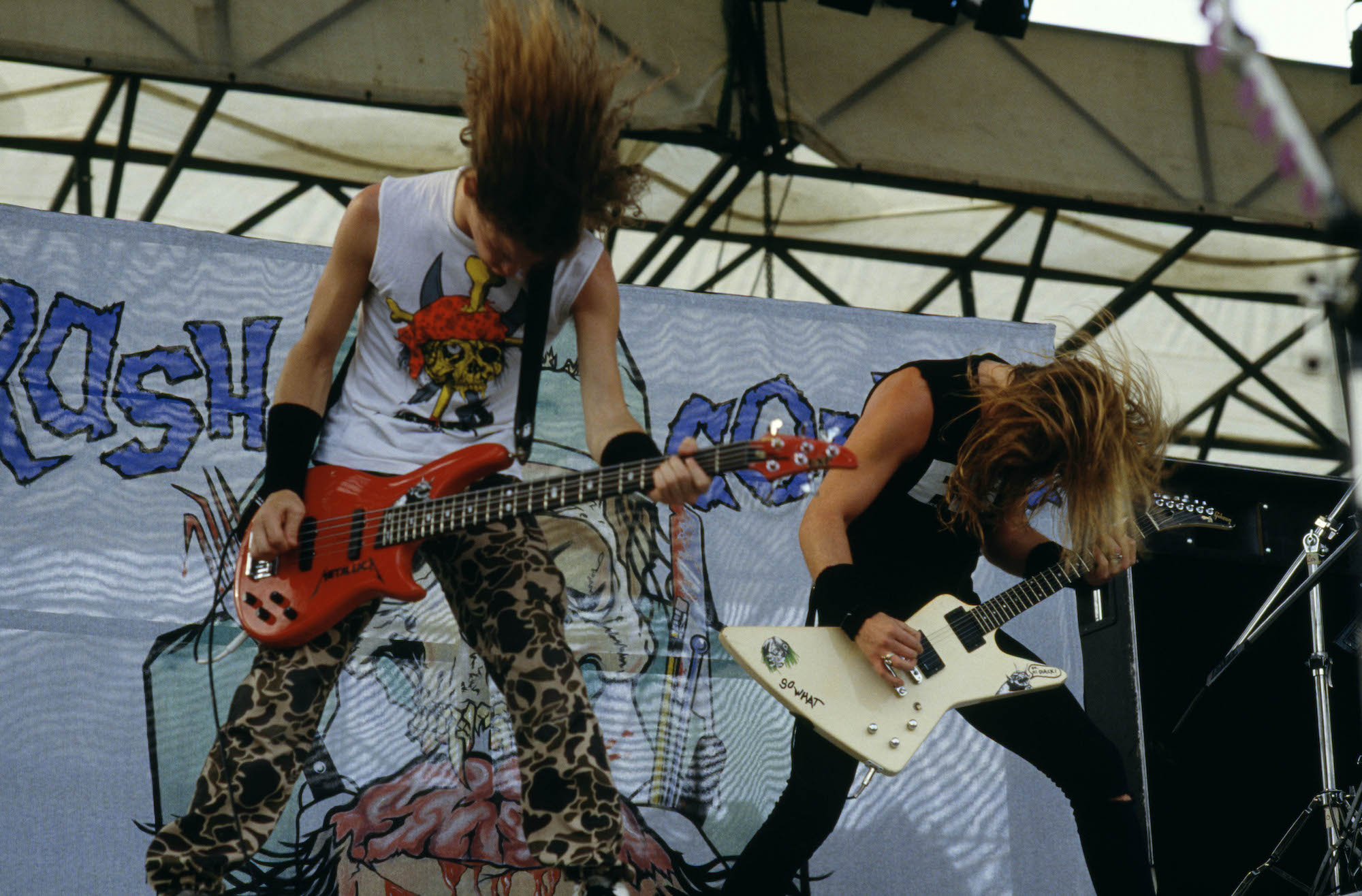
Jason Newsted: “When I came into Metallica, I had to do justice to Cliff’s work, but I also had to put my own signature on it. No one could be Cliff Burton; Cliff Burton was the Jimi Hendrix of bass. I had to practice, practice, practice to get anywhere close to where he was.”
Holt: “After all these years, anyone who plays bass in Metallica is still filling Cliff Burton’s shoes. There was nobody like him.”
With Newsted onboard, Metallica head back out to the road, touring America and Europe with Metal Church, and ending with three shows as part of the Monsters of Rock festival. In the summer of 1987, they return to L.A. and record The $5.98 E.P.: Garage Days Re-Revisited. The set features covers of songs by Metallica favorites the Misfits, Budgie, and NWOBHM legends Diamond Head.
Hammett: “We did that EP for the fans, just for fun, and Elektra loved it and released it. All the lead parts flowed really quickly; I did them in two nights. That was when I first started using ESP guitars with EMG pickups.”
Hetfield: “We were still dealing with Cliff’s death, and Q-Prime, our management, was telling us to jump right back into it and start playing again. I guess we kind of mourned through music and doing the cover songs on that album.”
…And Justice for All
In January 1988, Metallica reconvene with producer Flemming Rasmussen, this time at One On One Studios in Los Angeles, to begin work on their fourth full-length album.
Titled …And Justice for All, the effort is the most progressive and technically challenging in the band’s catalog, boasting just nine songs for a combined length of more than one hour.
Hammett: “Things changed after Cliff’s death. Even our sound changed. On Justice, we kind of fell prey to that whole virtuosic, late-Eighties thing that was happening. All of a sudden, everyone wanted to be progressive and show off their abilities. Somehow, just playing fast and heavy took a backseat to that.”
Hetfield: “Sometimes we look back at some of our material and wonder how – or why – we ever came up with certain parts. There was a lot of urgency to that material, but a lot of it was just wank – just us showing off. But that’s where we were at that time.”
Though the album is Newsted’s first full-length effort with Metallica, his bass parts are almost completely inaudible on the finished product. This is widely believed to be the result of the rest of the band’s “hazing” of the bassist, though they deny the charge.
Hetfield: “The bass was obscured for two reasons. First, Jason tended to double my rhythm guitar parts, so it was hard to tell where my guitar started and his bass left off. Also, my tone on Justice was very scooped – all lows and highs, with very little midrange.
“When my rhythm parts were placed in the mix, my guitar sound ate up all the lower frequencies. Jason and I were always battling for the same space in the mix.”
Newsted: “I can’t explain how much grief I dealt with – and still deal with – over that record.”
Hammett: “There was a lot of anguish after Cliff died, and basically Jason was the punching bag. We vented so much on him, and it wasn’t really fair.”
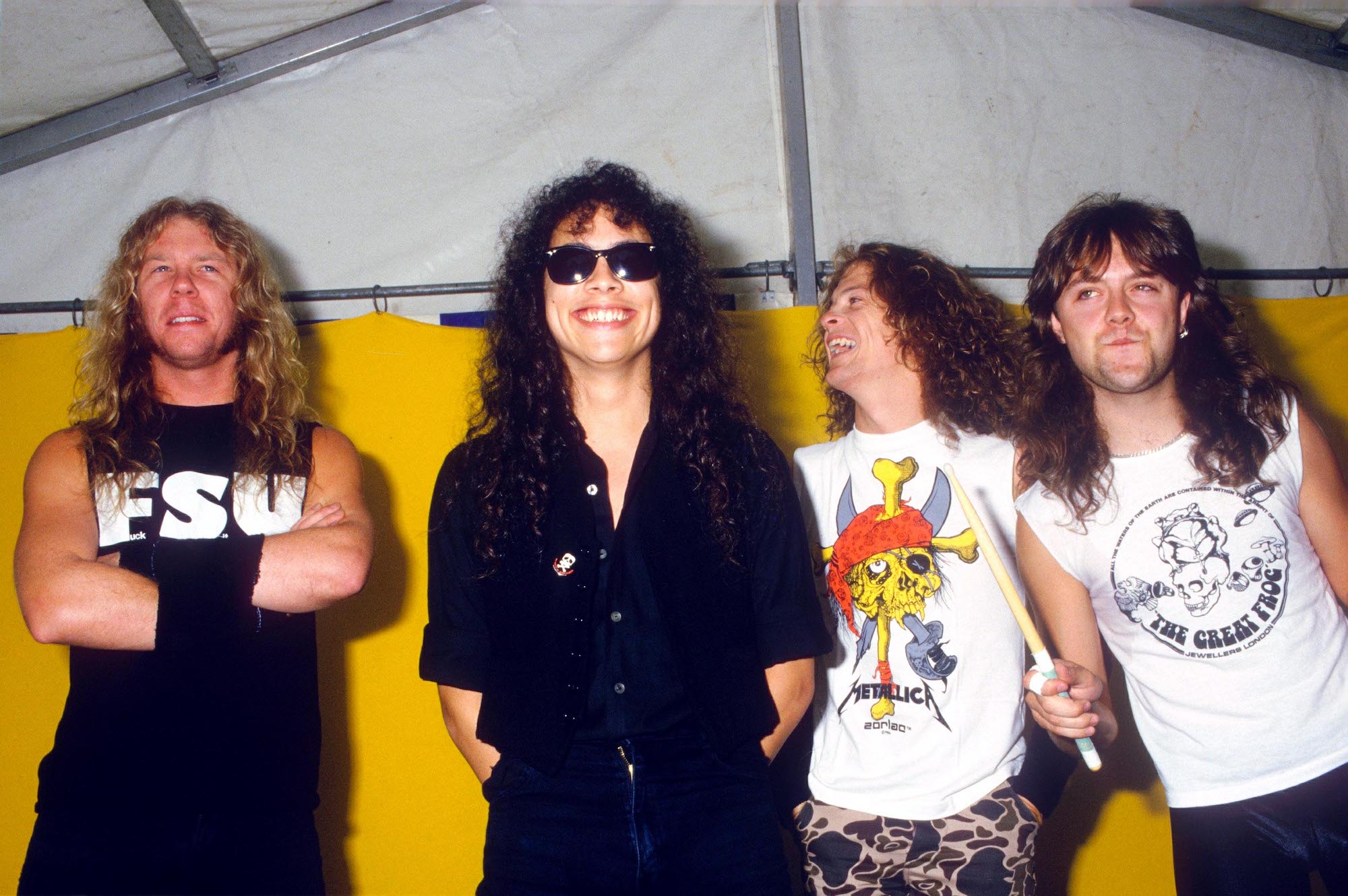
…And Justice for All is released on September 6, 1988, and becomes Metallica’s biggest album to date. It is also their mainstream breakthrough. This is in large part due to the success of the song One, for which the band films their first music video. In the video, Hetfield’s dark lyrics are set against disturbing images from the 1971 film adaptation of Dalton Trumbo’s antiwar novel, Johnny Got His Gun.
Hetfield: “We’d never done a video until then because we’d never been asked to. We certainly didn’t want to get to the position where we had to beg MTV to play one of our videos.
“Our fans were calling them up and asking for our videos to be played. MTV were like, ‘Who the hell are Metallica?’ But they ended up asking us to make a video. So we finally did one, and we did it our way. And, of course, it was incredibly disturbing.”
Hammett: “I knew we were on to a good thing when I saw One on MTV at, like, 11:30 in the evening. I watched it, and afterward the VJ came on and said, ‘Wow, that’s a real bowl of rainbows!’”
In the wake of the album’s massive success – it peaks at #6 on the Billboard album chart, and is certified Platinum in less than three months – Metallica embark on ‘Damaged Justice,’ their first headlining arena tour, which takes them around the world and stretches on for more than a year.
One is also nominated for a Grammy – the first year the Recording Academy offers the Best Hard Rock/Metal Performance category – but the band lose to Jethro Tull, a band whose music is neither hard rock nor metal.
Ulrich: “I’d be lying if I didn’t tell you I was disappointed. Human nature is that you’d rather win than lose, but Jethro Tull walking away with it makes a huge mockery of the intentions of the event.”
A Sticker on the cover of subsequent copies of …And Justice for All reads: “Grammy Award LOSERS.”
The Black Album
After completing the ‘Damaged Justice’ tour, Metallica return to One On One Studios in October 1990 to record their fifth studio album. The music they write and record largely eschews their thrash metal roots in favor of a decidedly more commercial sound with slower tempos, simpler guitar riffs, and shorter, more accessible songs.
James Hetfield’s vocals are more melodic as well. This change in sound is credited by many to the influence of producer Bob Rock, best known for his work with radio-friendly acts like Bon Jovi and Mötley Crüe.
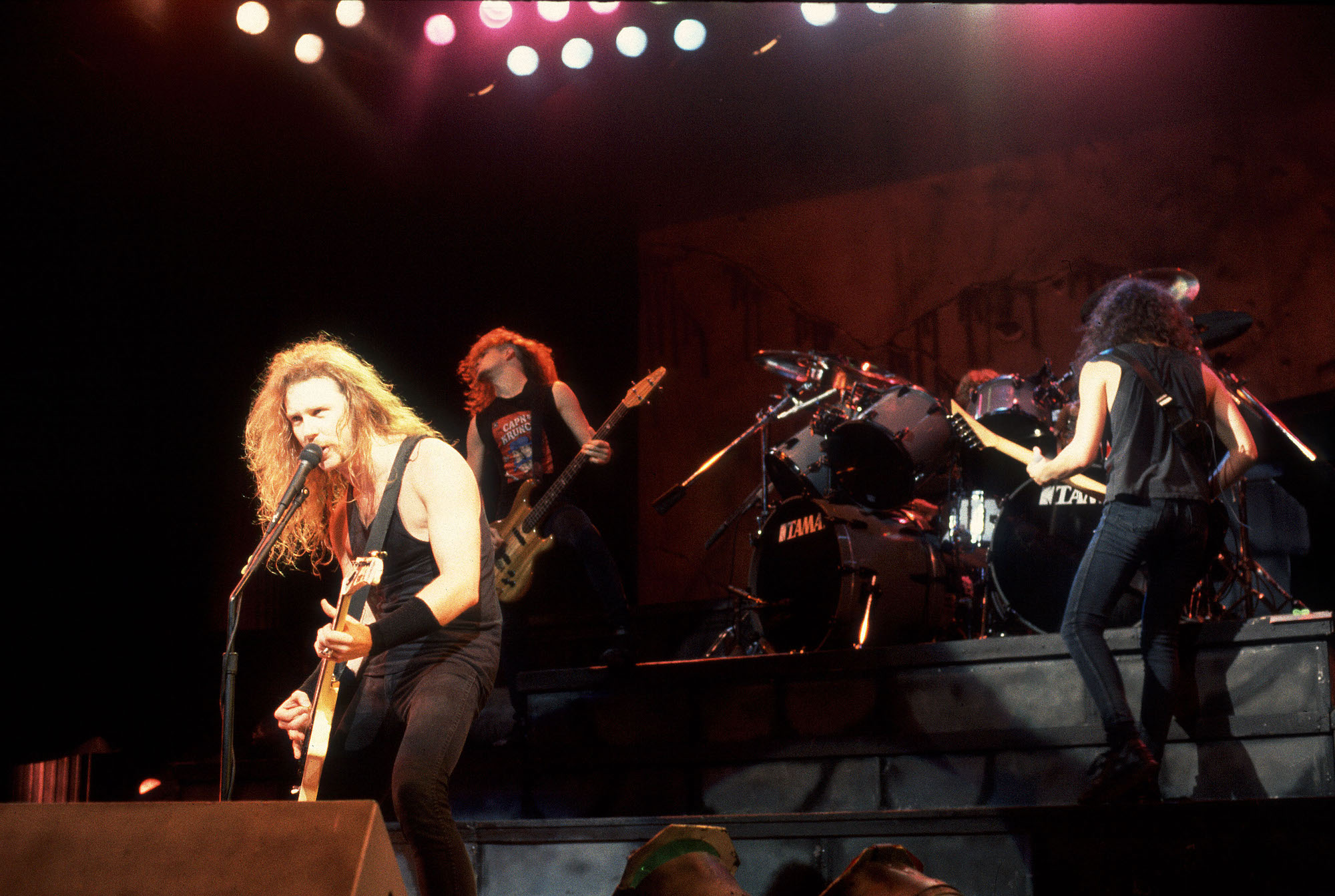
Hetfield: “People will be saying Bob [Rock] made Metallica sound like Bon Jovi. They don’t realize that no one screws with us, except us.”
Ulrich: “One thing that Bob should be given total credit for is making James comfortable enough to take that guard down and really sing. We’ve always thought of ourselves as Big Bad Metallica, but Bob taught us a new word none of us had ever heard before: ‘soulful.’”
Hetfield: “Radio airplay wasn’t the whole idea behind our writing shorter songs. It seemed to us that we had pretty much done the longer song format to death. We had one song that has just two riffs in it, which is pretty amazing. It only takes two minutes to get the point across.”
By the time the new album is released, on August 13, 1991, Metallica have been in the studio for close to a year, and the cost of the production reaches one million dollars. They choose to title the record Metallica, though due to its stark cover image – a coiled snake against a black background – it comes to be known as the “Black Album.”
Newsted: “It took us a long time to think up that title. I guess we could have just called it ‘Five’ or named it after one of the songs. We wanted to keep it simple.”
Ulrich: “The songs aren’t so busy, and Kirk’s guitar playing fits in well when he plays with the laid-back drums. James and I tried to set things up that were easier for Kirk to solo over. Some of the things on Justice got a little out of hand. Then it was, ‘Okay, Kirk, solo over this!’ And it would be the most sideways, difficult thing.”
Newsted: “The bass sound is much weightier. I tried to create a real rhythm section rather than a one-dimensional sound. It comes down to the music – making it a real rhythm section for once, and letting the guitars do their work. I’m glad the rest of the band could tell me that that’s what was needed.”
Hetfield: “What we really wanted was a live feel. In the past, Lars and I constructed the rhythm parts without Kirk and Jason. This time I wanted to try playing as a band unit in the studio. It lightens things up and you get more of a vibe.”
I stood there in my hotel room, and there was this fax that said, ‘You’re number one.’ And it was like, ‘Well, okay.’ It was just another fucking fax from the office
Lars Ulrich
Hammett: “I used a Bradshaw preamp for the lows and mids and a couple of Marshalls for the nice clean highs. We EQ’d it through the board a little bit, and it worked out great. And I used two guitars – a Strat-style ESP with two EMG [pickups] and an ’89 Les Paul Deluxe with two EMGs.”
Hetfield: “We tried a bunch of amps, but I ended up using the same Mesa/Boogie Mark II Simul Class that I’d used on the last three albums. My primary guitar was my ESP Explorer with EMGs, but I also used a Telecaster, a Gretsch White Falcon with a Bigsby, and a Guild 12-string.”
The album’s lead-off track, Enter Sandman, is propelled by a simple and hooky riff and a huge, sing-along chorus. It becomes a worldwide smash hit.
Hetfield: “I can remember when I wrote the lyrics to Enter Sandman, Bob Rock and Lars came to me and said, ‘These aren’t as good as they could be.’ And that pissed me off so much. I was like, ‘Fuck you! I’m the writer here!’ That was the first challenge from someone else, and it made me work harder.”
Hammett: “I think the time has come to reveal where I actually got the guitar lick before the breakdown in Enter Sandman: It’s from Magic Man, by Heart, but I didn’t get it from Heart’s version; I got it from a cut off Ice-T’s Power album, where he sampled it. I heard that and thought, ‘I have to snake this!’”
Mainstream music fans wholeheartedly embrace the new, friendlier Metallica. The “Black Album” enters the Billboard album chart at number one and sells 600,000 copies in its first week of release.
In addition to Enter Sandman, the record spawns five more hit singles, including The Unforgiven, Wherever I May Roam, and the acoustic ballad Nothing Else Matters. The album has since sold more than 22 million copies worldwide.
Ulrich: “You think one day some fucker’s going to tell you, ‘You have a number-one record in America’ and the whole world will ejaculate. I stood there in my hotel room, and there was this fax that said, ‘You’re number one.’ And it was like, ‘Well, okay.’ It was just another fucking fax from the office.”
Beyond the Black
In October 1991, Metallica embark on the ‘Wherever We May Roam’ tour. They stay on the road for close to three years, in the process becoming one of the biggest touring and recording acts in the world.
Over the next decade the band release a series of albums – Load, ReLoad, St. Anger – on which they continually reinvent their sound (and image), gaining – and losing – fans in the process.
In 2001, Jason Newsted leaves Metallica due to strained relations with the rest of the band, in particular James Hetfield. In 2003 he is replaced by ex–Suicidal Tendencies and Ozzy Osbourne bassist Robert Trujillo, who joins prior to the tour in support of St. Anger.

In September 2008, Metallica release their ninth studio album, Death Magnetic. To date they’ve sold more than 90 million records worldwide, and remain one of the most influential and successful bands in hard rock and heavy metal.
Hammett: “I think Metallica have a lot more to say. We’re the type of band that likes to experiment. We don’t like to stay in one spot for too long; all the albums after the ‘Black Album’ prove that. We’re not afraid to take artistic risks, even at the cost of pissing off our audience and our friends.”
Hetfield: “The cool thing about Metallica is that there’s always a new generation of angry young men who latch onto Kill ’Em All and know what I’m talking about. And maybe they grow up with the rest of the records.
“We’ve never been about creating some fantasy world with our records; we’re just documenting where we’re at at the time. There’s always going to be youth on the planet, and whether they can relate to that or not, I don’t know. But every time I look out in the crowd and see some kids battling it out in the middle of the mosh pit, I’m like, ‘Yeah, I was there, man.’”
Hammett: “We want to get out there and show people how strong Metallica are. It’s not a mask and it’s not bullshit. We feel really good about being us right now, and here we are. Now, see if you can hang on.”
This feature was originally published in the December 2008 issue of Guitar World.
Rich is the co-author of the best-selling Nöthin' But a Good Time: The Uncensored History of the '80s Hard Rock Explosion. He is also a recording and performing musician, and a former editor of Guitar World magazine and executive editor of Guitar Aficionado magazine. He has authored several additional books, among them Kurt Cobain: Montage of Heck, the companion to the documentary of the same name.
![Metallica - (Anesthesia)—Pulling Teeth [Original 1983 Studio Recording] - YouTube](https://img.youtube.com/vi/NTRltGBsJ6s/maxresdefault.jpg)



![Metallica - Live in Stockholm [Cliff's Last Show (1986)] [Audio Upgrade] - YouTube](https://img.youtube.com/vi/An6PNt1j0wA/maxresdefault.jpg)




